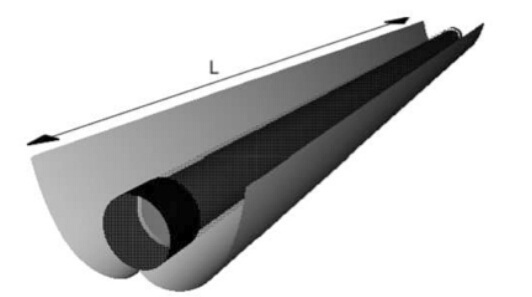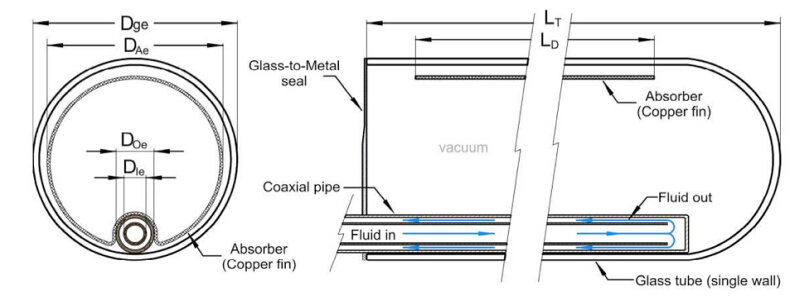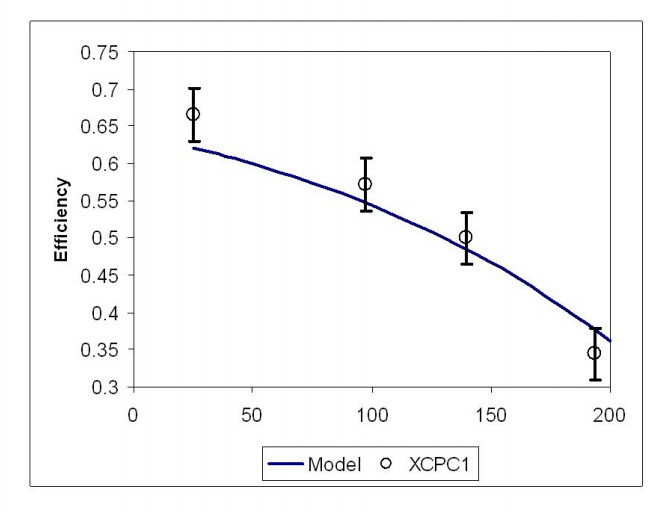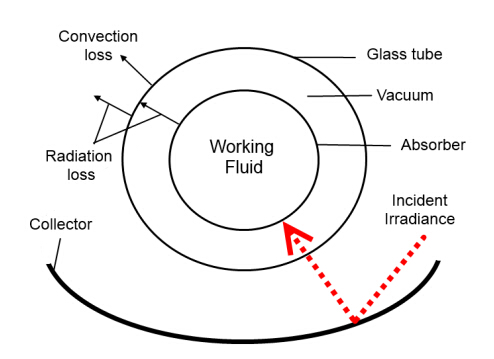This paper explores the benefits and drawbacks of using carbon dioxide in solar thermal systems at medium and high operating temperatures. For medium temperatures, application of CO2 in non-imaging-optics based compound parabolic concentrators (CPC) combined with evacuated-tube collectors is studied. These collectors have been shown to obtain efficiencies higher than 40% operating at around 200℃ without the need of tracking. Validated numerical models of external compound parabolic concentrators (XCPCs) are used to simulate their performance using CO2 as working fluid. For higher temperatures, a mathematical model is implemented to analyze the operating performance of a parabolic trough solar collector (PTC) using CO2 at temperatures between 100℃ and 600℃.
1.
Introduction
In 1925, R. Nevanlinna [8] extended the classical theorems of Picard and Borel by developing the value distribution theory of meromorphic functions on the complex plane $ \mathbb{C} $, which is now called Nevanlinna theory. As its application, Nevanlinna derived the well known five values theorem and four values theorem: two nonconstant distinct meromorphic functions on $ \mathbb{C} $ cannot have the same inverse images of five distinct values; they must be linked by a Möbius transformation if they share four values counting multiplicities. Since then, the uniqueness problem related to sharing values or functions has been widely studied.
In 1997, T. Czubiak and G. Gundersen [3] proved the following result.
Theorem A. Let $ f $ and $ g $ be two non constant meromorphic functions on $ \mathbb{C} $ that share six pairs of values $ (a_i, b_i) $, $ 1 \leq i \leq 6 $, IM (ignoring multiplicities), where $ a_i, b_i \in \mathbb{C} $ and $ a_i \neq a_j $, $ b_i \neq b_j $ whenever $ i\neq j $, i.e.,
Then $ f $ is a Möbius transformation of $ g $.
Li and Yang [6] gave an example which was found by G. G. Gundersen in 1979 and showed that the number of pairs of values in Theorem A cannot be replaced by a smaller one. After that, many authors studied the sharing pairs of values problem of meromorphic functions on $ \mathbb{C} $. There are some extensions of the above result, where the pairs of values are replaced by pairs of small functions (e.g., see [7,13,15]).
By the Doubly Connected Mapping Theorem, each doubly connected domain is conformally equivalent to the annulus $ \mathbb{A}(r; R) = \{z: 0 \leq r < |z| < R \leq +\infty\} $. However $ \mathbb{A}(r; R) $ is biholomorphic to $ \mathbb{A}(R_0) = \{z: \frac{1}{R_0} < |z| < R _0\} $ for some $ R_0 \in (1, +\infty] $. In fact, if $ r > 0 $ and $ R = +\infty $, set $ z\rightarrow \frac{1}{z-r} $, $ R_0 = +\infty $; if $ r = 0 $ and $ R < +\infty $, set $ z\rightarrow \frac{z}{R-z} $, $ R_0 = +\infty $; if $ 0 < r < R < +\infty $, set $ z\rightarrow \frac{z}{\sqrt{rR}}, R_0 = \sqrt{\frac{R}{r}} $.
Recently, Khrystiyanyn and Kondratyuk (see [4,5]) proposed the Nevanlinna theory for meromorphic functions on annuli. Using the second main theorem for meromorphic functions on annuli, Cao, Yi and Xu in [2] proved a uniqueness theory of meromorphic functions on annuli sharing values. Quang and Tran [13] studied the case where the meromorphic functions on annuli share some pairs of values with truncated multiplicities and obtained the following result.
Theorem B. Let $ f $ and $ g $ be two admissible meromorphic functions on $ \mathbb{A}(R_0)\; (1 < R_0\leq +\infty) $. Let $ \{(a_i, b_i)\}_{i = 1}^q\; (q\geq 6) $ be $ q $ pairs of values, where $ a_i \neq a_j $, $ b_i \neq b_j $ whenever $ i\neq j $. Let $ k_i\; (1\leq i\leq q) $ be $ q $ positive integers or $ +\infty $ with $ k_1 \geq k_2 \geq \dots \geq k_q $ such that
for an integer number $ m \in\{1, 2, \dots, q\} $. Assume that
Then $ f $ is a Möbius transformation of $ g $.
Here, the meromorphc function $ f $ on $ \mathbb{A}(R_0) $ is said to be admissible if it satisfies
or
where $ T_0(r, f) $ is the characteristic function of $ f $ (see Section 2 for details).
For the case of meromorphic functions on the complex plane $ \mathbb{C} $, there is a sharp second main theorem for small functions given by Yamanoi [14]. Therefore, in that case, all authors used the Cartan's auxialiary functions and got nice results. However, in the case of functions on annuli, there is no sharp second main theorem for small function. In the light of [9], we study the case that the functions on annuli share $ q\; (q\geq 5) $ small functions and get the following result.
Theorem 1.1. Let $ f $ and $ g $ be two admissible meromorphic functions on $ \mathbb{A}(R_0)\; (1 < R_0\leq +\infty) $. Let $ \{(a_i(z), b_i(z))\}_{i = 1}^q \; (q\geq 5) $ be $ q $ pairs of small (with respect to $ f $ and $ g $) functions on $ \mathbb{A}(R_0) $, where $ a_i(z) \not\equiv a_j(z) $, $ b_i(z) \not\equiv b_j(z) $ for every $ z\in \mathbb{A}(R_0) $ and $ i\neq j $. Let $ k_i \geq 4\; (1\leq i\leq q) $ be $ q $ positive integers or $ +\infty $ such that
Assume that
Then $ f $ is a quasi-Möbius transformation of $ g $.
Here, we say that $ f $ is a quasi-Möbius transformation of $ g $ if there exist four small functions (with respect to $ f $ and $ g $) $ a, b, c, d $ with $ ad-bc \not\equiv 0 $ such that $ f = \frac{ag + b}{cg + d} $.
For the case of meromorphic functions sharing four pairs of small functions, we will prove the following.
Theorem 1.2. Let $ f $ and $ g $ be two admissible meromorphic functions on $ \mathbb{A}(R_0)\; (1 < R_0\leq +\infty) $. Let $ \{(a_i(z), b_i(z))\}_{i = 1}^4 $ be four pairs of small (with respect to $ f $ and $ g $) functions on $ \mathbb{A}(R_0) $, where $ a_i(z) \not \equiv a_j(z) $, $ b_i(z) \not \equiv b_j(z) $ whenever $ i\neq j $. Let $ k_i \geq 4\; (1\leq i\leq 4) $ be positive integers or $ +\infty $ such that
Assume that
Then $ f $ is a Möbius transformation of $ g $.
Let $ k_1 = \cdots = k_q = k $, we have the following corollary.
Corollary 1.3. Let $ f $ and $ g $ be two admissible meromorphic functions on $ \mathbb{A}(R_0)\; (1 < R_0\leq +\infty) $. Let $ \{(a_i(z), b_i(z))\}_{i = 1}^q $ be $ q $ pairs of small (with respect to $ f $ and $ g $) functions on $ \mathbb{A}(R_0) $, where $ a_i(z) \not\equiv a_j(z) $, $ b_i(z) \not\equiv b_j(z) $ whenever $ i\neq j $. Let $ k $ be a positive integer or $ +\infty $ such that $ k > 433 $ if $ q\geq 5 $ and $ k > 578 $ if $ q = 4 $. Assume that
Then $ f $ is a quasi-Möbius transformation of $ g $.
Furthermore, we consider the two admissible meromorphic functions on $ \mathbb{A}(R_0) $ sharing $ 4 $ pairs of values and obtain:
Theorem 1.4. Let $ f $ and $ g $ be two admissible meromorphic functions on $ \mathbb{A}(R_0)\; (1 < R_0\leq +\infty) $. Let $ \{(a_i, b_i)\}_{i = 1}^4 $ be four pairs of values, where $ a_i \neq a_j $, $ b_i \neq b_j $ whenever $ i\neq j $. Let $ k_i\geq 4\; (1\leq i\leq 4) $ be positive integers or $ +\infty $ such that $ \sum_{i = 1}^4 \frac{289}{k_i +289} < 2. $ Assume that
Then $ f $ is a Möbius transformation of $ g $. Moreover there is a permutation $ (i_1, i_2, i_3, i_4) $ of $ (1, 2, 3, 4) $ such that
When $ k_1 = \cdots = k_4 = k $, Theorem 1.4. implies the following corollary.
Corollary 1.5. Let $ f $ and $ g $ be two admissible meromorphic functions on $ \mathbb{A}(R_0)\; (1 < R_0\leq +\infty) $. Let $ \{(a_i, b_i)\}_{i = 1}^4 $ be four pairs of values, where $ a_i \neq a_j $, $ b_i \neq b_j $ whenever $ i\neq j $. Let $ k > 289 $ be a positive integer or $ +\infty $ such that
Then $ f $ is a Möbius transformation of $ g $.Moreover there is a permutation $ (i_1, i_2, i_3, i_4) $ of $ (1, 2, 3, 4) $ such that
2.
Some definitions and results from Nevanlinna theory on annuli
First of all, we will recall some basic notions of Nevanlinna theory for meromorphic functions on annuli from [6] (see also [1,4,5]).
For a divisor $ \nu $ on $ \mathbb{A}(R_0)\; (1 < R_0\leq +\infty) $, which we may regard as a function on $ \mathbb{A}(R_0) $ with values in $ \mathbb{Z} $ whose support is discrete subset of $ \mathbb{A}(R_0) $, and for a positive integer $ M $ (maybe $ M = \infty $), we define the counting function of $ \nu $ as follows
and
For brevity, we will omit the character $ [M] $ if $ M = \infty $. For a divisor $ \nu $ and a positive integer $ k $ or $ +\infty $, we define:
For a meromorphic function $ \varphi $, we define $ \nu_\varphi^0 $ (resp. $ \nu^\infty_\varphi $) the divisor of zeros (resp. divisor of poles) of $ \varphi $; $ \nu_\varphi = \nu_\varphi^0- \nu^\infty_\varphi $; $ \nu_{\varphi, \leq k}^0 = (\nu_\varphi^0)_{\leq k}, \ \nu_{\varphi, > k}^0 = (\nu_\varphi^0)_{ > k} $. Similarly, we define $ \nu_{\varphi, \leq k}^\infty $, $ \nu_{\varphi, > k}^\infty $, $ \nu_{\varphi, \leq k} $, $ \nu_{\varphi, > k} $ and their counting functions. For a discrete subset $ S \subset \mathbb{A}(R_0) $, we consider it as a reduced divisor (denoted again by $ S $) whose support is $ S $, and denote by $ N_0(r, S) $ its counting function. We also set $ \chi_S(z) = 0 $ if $ z\not\in S $ and $ \chi_S(z) = 1 $ if $ z \in S $.
Let $ f $ be a nonconstant meromorphic function on $ \mathbb{A}(R_0) $. The proximity function of $ f $ is defined by
and the characteristic function of $ f $ is defined by
Throughout this paper, we denote by $ S_f (r) $ quantities satisfying:
(i) in the case $ R_0 = +\infty $,
for $ r\in(1, R_0) $ except for a set $ \Delta_R $ such that $ \int_{\Delta_R}r^{\lambda-1}dr < +\infty $ for some $ \lambda \geq 0 $.
(ii) in the case $ R_0 < +\infty $,
for $ r \in(1, R_0) $ except for a set $ \Delta_R^\prime $ such that $ \int_{\Delta_R^\prime}\frac{1}{(R_0 - r)^{\lambda+1}}dr < +\infty $ for some $ \lambda \geq 0 $.
Thus for an admissible meromorphic function $ f $ on the annulus $ \mathbb{A}(R_0) $, we have $ S_f(r) = o(T_0(r, f)) $ as $ r \rightarrow R_0 $ for all $ 1 \leq r < R_0 $ except for the set $ \Delta_R $ or the set $ \Delta_R^\prime $ mentioned above, respectively [1]. A meromorphic function a on $ \mathbb{A}(R_0) $ is said to be small with respect to $ f $ if $ T_0(r, a) = S_f (r) $.
Lemma 2.1. (Lemma on logarithmic derivatives [1,4,5,6]) Let f be a nonzero meromorphic function on $ \mathbb{A}(R_0) $. Then for each $ k \in \mathbb{N} $ we have
Theorem 2.2. (First main theorem for meromorphic functions and small functions [11]) Let $ f $ be a meromorphic function on $ \mathbb{A}(R_0) $ and $ a $ be a small function with respect to $ f $. Then we have
Theorem 2.3. (Second main theorem [1]) Let $ f $ be a nonconstant meromorphic function on $ \mathbb{A}(R_0) $. Let $ a_1, \dots, a_q $ be $ q $ distinct values in $ \mathbb{C} \cup\{\infty\} $. We have
Theorem 2.4. (Second main theorem with small function (see [15], Lemmas 3.1, 3.2)) Let $ f $ be a nonconstant meromorphic function on $ \mathbb{A}(R_0) $. Let $ a_1, \dots, a_5 $ be $ 5 $ distinct small functions with respect to $ f $. We have
From Theorem 2.4, we easily get the following theorem.
Theorem 2.5. (Second main theorem with small function) Let $ f $ be a nonconstant meromorphic function on $ \mathbb{A}(R_0) $. Let $ a_1, \dots, a_q $ be $ q\; (q\geq 5) $ distinct small functions with respect to $ f $. We have
3.
Nevanlinna theory for holomorphic mappings from an annulus into a projective space
Let $ f $ be a holomorphic mapping from an annulus $ \mathbb{A}(R_0) $ into $ P^N (\mathbb{C}) $ with a reduced representation $ f = (f_0 : \dots : f_N) $. For $ 1 < r < R_0 $, the Nevanlinna-Cartan's characteristic function $ T_0(r, f) $ of $ f $ is defined by
where $ \parallel f \parallel = (|f_0|^2 +\dots+|f^N|^2)^\frac{1}{2}. $
Let $ H $ be a hyperplane in $ P^N (\mathbb{C}) $ given by $ H = \{(\omega_0 : \cdots : \omega_N) | a_0\omega_0 + \cdots + a_N\omega_N = 0\} $. We set $ (f, H) = a_0 f_0 +\cdots+a_N f_N $. The proximity function of $ f $ with respect to $ H $ is defined by
where $ \parallel H \parallel = (|a_0|^2 +\dots+|a^N|^2)^\frac{1}{2} $. By Jensen's formula, we have the First Main Theorem for a holomorphic mapping from an annulus $ \mathbb{A}(R_0) $ into $ P^N (\mathbb{C}) $ as follows.
where $ f^*H $ denotes the pull back divisor of $ H $ by $ f $.
Remark Let $ f $ be a meromorphic function on $ \mathbb{A}(R_0) $. We may regard $ f $ as a holomorphic curve from $ A(R_0) $ into $ P^1(\mathbb{C}) $. Similarly to the case of meromorphic functions on $ \mathbb{C} $, we see that the above two definitions of characteristic function $ T_0(r, f) $ coincide to each other up to a constant.
Proposition 3.1. [11] Let $ f $ be a holomorphic mapping from an annulus $ \mathbb{A}(R_0) $ into $ P^N (\mathbb{C}) $. Let $ H $ and $ G $ be two distinct hyperplanes of $ P^N(\mathbb{C}) $, then we have
Proof. By the definition of the characteristic function and the property of the function $ \log^+ $ (for positive numbers $ a $ and $ b $, $ \log^+(ab)+\log b \leq \log(a^2+b^2)^\frac{1}{2}, a, b > 0 $), we have
Let $ \{H_i \}_{i = 1}^q\ (q \geq N +2) $ be a set of $ q $ hyperplanes in $ P^N(\mathbb{C}) $. We say that the family$ \{H_i \}_{i = 1}^q $ is in general position if $ \cap_{j = 1}^{N+1}H_{i_j} = \emptyset $ for any $ 1\leq i_1 < \cdots < i_{N+1} \leq q $.
In 2015, H. T. Phuong and N. V. Thin [10] proved the following Second Main Theorem for holomorphic curves from an annulus into $ P^N(\mathbb{C}) $.
Theorem 3.2. Let $ f : \bf{A}(R_0) \rightarrow P^N (\mathbb{C}) $ be a linearly nondegenerate holomorphic mapping. Let $ \{H_i\}_{i = i}^q $ $ (q \geq N + 2) $ be a set of q hyperplanes in $ P^N (\mathbb{C}) $ in general position. Then
where $ f^*H_i $ denotes the pull back divisor of $ H_i $ by $ f $.
4.
Proofs of main theorems
In order to prove the main theorems, we need some lemmas.
Lemma 4.1. Let $ f $ be a nonconstant meromorphic function on $ \mathbb{A}(R_0) $ and $ a(z) $ be a small function (with respect to $ f $) on $ \mathbb{A}(R_0) $. Then for each positive integer $ k $ (may be $ \infty $) we have
Proof. Since $ N_0^{[1]}(r, \nu_{f-a, \leq k}) \leq N_0(r, \nu_{f-a, \leq k}) $ and $ N_0(r, \nu_{f-a}) \leq T_0(r, f) + S_f (r) $, we have
Lemma 4.2. Let $ f $ and $ g $ be two admissible meromorphic functions on $ \mathbb{A}(R_0)\; (1 < R_0\leq +\infty) $. Let $ \{(a_i(z), b_i(z))\}_{i = 1}^3 $ be three pairs small (with respect to $ f $ and $ g $) functions on $ \mathbb{A}(R_0) $, where $ a_i(z) \not\equiv a_j(z) $, $ b_i(z) \not\equiv b_j(z) $ whenever $ i\neq j $. Assume that $ f $ is not a quasi-Möbius transformation of $ g $. We have the following inequality
where $ \nu $ is the divisor defined by $ \nu(z) = \max \{0, \min \{\nu_{f-a_3}^0, \nu_{g-b_3}^0 \}-1\} $ and $ S(r) = S_f(r)+S_g(r) $.
Proof. By replacing $ f $ and $ g $ by $ \frac{(f-a_1)(a_3-a_2)}{(f-a_2)(a_3-a_1)} $ and $ \frac{(g-b_1)(b_3-b_2)}{(g-b_2)(b_3-b_1)} $ if necessary, we may assume that $ a_1 = b_1 = 0, a_2 = b_2 = \infty $ and $ a_3 = b_3 = 1 $. Since $ f $ is not quasi-Möbius transformation of $ g $,
By the lemma on logarithmic derivatives, it follows that
We also see that $ h $ has only simple poles, and it must be either $ \nu_f^0 (z)\neq\nu_g^0 (z) $, or $ \nu_f^\infty (z)\neq\nu_g^\infty (z) $. Then
On the other hand,
This yields
By the first main theorem, we easily see that
The Lemma is proved.
Lemma 4.3. Let $ f $ and $ g $ be two admissible meromorphic functions on $ \mathbb{A}(R_0)\; (1 < R_0\leq +\infty) $. Let $ \{(a_i, b_i)\}_{i = 1}^4 $ be four pairs of small (with respect to $ f $ and $ g $) functions on $ \mathbb{A}(R_0) $, where $ a_i \not \equiv a_j $, $ b_i(z) \not \equiv b_j(z) $ whenever $ i\neq j $. Let $ k_i\; (1\leq i\leq 4) $ be positive integers or $ +\infty $ such that
Assume that $ f $ is not a quasi-Möbius transformation of $ g $. Then
where $ S(r) = S_f(r)+S_g(r) $.
Proof. For each $ 1\leq i \leq 4 $, we define the divisors $ \nu_i $ and $ \mu_i $ as follows
Take three indices $ i, j, t \in \{1, 2, 3, 4\} $. By Lemma 4.2, we have
Summing-up both sides of the above inequality over all subsets $ \{i, j, t \} $ of $ \{1, 2, 3, 4 \} $, we obtain
Put
We easily see that $ c_1 \not \equiv c_2, c_1^\prime \not \equiv c_2^\prime, \alpha \not \equiv 1, \beta \not \equiv 1 $, all $ c_i, c_i^\prime $ $ (i = 1, 2), \alpha, \ \beta $ are small with respect to $ f $ and $ g $, and
Moreover, we have the following equations system:
Thus
This implies
Denote by $ \mathcal{I} $ the set of all subsets $ I = \{i, j\} $ of the set $ \{1, 2, 3, 4\} $. For $ I \in\mathcal{I} $, we define the function $ h_I $ as follows:
Therefore $ \sum_{I\in \mathcal{I}}h_I = 0 $. Choose a meromorphic function $ d $ on $ \mathbb{A}(R_0) $ such that $ dh_I\ (I \in\mathcal{I}) $ are all holomorphic functions on $ \mathbb{A}(R_0) $ without common zero. By Eq (4.2), we have
Take each $ I_0\in \mathcal{I} $, then
Denote by $ t_{I_0} $ $ (1\leq t_{I_0} \leq 5) $ the minimum number satisfying the following: There exist $ t_{I_0} $ elements $ I_1, \cdots, I_t \in \mathcal{I} $ and $ t_{I_0} $ nonzero constants $ \beta_\nu \in \mathbb{C}\ (1 \leq \nu \leq t_{I_0}) $ such that $ dh_{I_0} = \sum_{\nu = 1}^{t_{I_0}}\beta_\nu dh_{I_\nu} $. Set $ t: = \max\{t_{I_0}: I_0\in \mathcal{I}\} $.
By the minimality of $ t $, the family $ \{dh_{I_1}, \cdots, dh_{I_t}\} $ is linearly independent over $ \mathbb{C} $.
Case 1. $ t = 1 $, then for each $ I \in \mathcal{I} $, there exists $ J\in \mathcal{I} \setminus \{I\} $ such that $ \frac{h_I}{h_J}\in\mathbb{C}\setminus\{0\} $. We consider the following two cases:
(a). There exist $ I = \{i, j\}, J = \{i, l\}, j\neq l $ such that $ \frac{h_I}{h_J} = a $, where $ a \in\mathbb{C}\setminus\{0\} $. Then $ h_j = ah_l $. Therefore, $ f $ is a quasi-Möbius transformation of $ g $. This is a contradiction.
(b). Otherwise, there exist nonzero constants $ b, c \in\mathbb{C}\setminus\{0\} $ such that $ h_{\{1, 2\}} = bh_{\{3, 4\}} $ and $ h_{\{1, 3\}} = ch_{\{2, 4\}} $. This implies that
Then $ \left(\frac{h_1}{h_4}\right)^2 = \frac{bc(1-\beta)}{1-\alpha} $. Hence $ f $ is a quasi-Möbius transformation of $ g $. This is a contradiction.
Case 2. $ 2\leq t\leq 5 $, consider the linearly non-degenerate holomorphic mapping $ h : \mathbb{C}\rightarrow P^{t-1}(\mathbb{C}) $ with the representation $ h = (dh_{I_1}: \cdots :dh_{I_t}) $. Applying Theorem 3.2 and the inequality (4.3), we have
We define the following rational functions:
For each $ I \subset \{1, \cdots, 4\} $, put $ I^c = \{1, \cdots, 4\} \setminus I $. For $ 0 \leq u, v \leq t, \ u \neq v $, then $ ((I_u \cup I_v)\setminus (I_u \cap I_v))^c = \emptyset $, or there exist $ i, j\in ((I_u \cup I_v)\setminus (I_u \cap I_v))^c $ and $ i\neq j $. Hence
Similarly, we have
We denote that $ ((I_0 \cup I_1)\setminus (I_0 \cap I_1))^c\cup ((I_1 \cup I_2)\setminus (I_1 \cap I_2))^c\cup ((I_2 \cup I_0)\setminus (I_2 \cap I_0))^c = \{1, \cdots, 4\} $. If $ ((I_0 \cup I_1)\setminus (I_0 \cap I_1))^c = \emptyset $, then $ ((I_1 \cup I_2)\setminus (I_1 \cap I_2))^c\cup ((I_2 \cup I_0)\setminus (I_2 \cap I_0))^c = \{1, \cdots, 4\} $, by Proposition 3.1, we have
If $ ((I_0 \cup I_1)\setminus (I_0 \cap I_1))^c \neq \emptyset $, by Proposition 3.1, we have
Therefore, we obtain
Using the inequalities (4.1), (4.4) and (4.5), we get
The lemma is proved.
Proof of Theorem 1.1. Suppose that $ f $ is not a quasi-Möbius transformation of $ g $. By Theorem 2.5 and Lemma 4.1, we have
From the assumption of the theorem, $ \sum_{i = 1}^{q}\frac{1}{k_i+1} < \sum_{i = 1}^q \frac{289}{k_i +289} < \frac{2q}{5} $. This implies that $ T_0(r, f) = O(T_0(r, g)) $. Similarly, $ T_0(r, g) = O(T_0(r, f)) $. Thus $ S_f(r) = S_g(r) $.
Denote $ T_0(r) = T_0(r, f) + T_0(r, g), S(r): = S_f(r) = S_g(r) $, applying Theorem 2.5 and Lemma 4.3:
Letting $ r\rightarrow R_0 $, we get $ \sum_{i = 1}^q \frac{289}{k_i +289} \geq \frac{2q}{5}. $ This is a contradiction. Hence $ f $ is a quasi-Möbius transformation of $ g $.
Proof of Theorem 1.2. Suppose that $ f $ is not a quasi-Möbius transformation of $ g $. Take three $ i, j, t\in\{1, 2, 3, 4\} $, replacing $ f $ and $ g $ by $ \frac{(f-a_i)(a_t-a_j)}{(f-a_j)(a_t-a_i)} $ and $ \frac{(g-b_i)(b_t-b_j)}{(g-b_j)(b_t-b_i)} $, if necessary, we may assume that $ a_i = b_i = 0, a_j = b_j = \infty $ and $ a_t = b_t = 1 $. Apply Theorem 2.3, we have
Summing-up both sides of the above inequality over all subsets $ \{i, j, t \} $ of $ \{1, 2, 3, 4 \} $, we have
Using Lemma 4.1, it yields that
From the assumption of the theorem $ \sum_{i = 1}^{4}\frac{1}{k_i+1} < \sum_{i = 1}^4 \frac{289}{k_i +289} < \frac{4}{3} $. This implies that $ T_0(r, f) = O(T_0(r, g)) $. Similarly, $ T_0(r, g) = O(T_0(r, f)) $. Thus $ S_f(r) = S_g(r) $.
Combinning the above inequality (4.6) and Lemma 4.3, similarly to the proof of Theorem 1.1, we obtain $ \sum_{i = 1}^q \frac{289}{k_i +289} \geq \frac{4}{3}. $ This is a contradiction. Hence $ f $ is a quasi-Möbius transformation of $ g $.
Lemma 4.4. Let $ f $ and $ g $ be two admissible meromorphic functions on $ \mathbb{A}(R_0)\; (1 < R_0\leq +\infty) $. Let $ \{(a_i, b_i)\}_{i = 1}^4 $ be four pairs of values, where $ a_i \neq a_j $, $ b_i \neq b_j $ whenever $ i\neq j $. Let $ k_i\; (1\leq i\leq 4) $ be positive integers or $ +\infty $ with $ 1\leq k_1\leq k_2 \leq \cdots \leq k_4 $ such that $ \frac{2}{k_1+1}+\frac{1}{k_2+1} < 1 $. Assume that
for all z outside a discrete subset $ S $ of counting function equal to $ S_f(r) + S_g(r) $. If $ f $ is a Möbius transformation of $ g $, then there is a permutation $ (i_1, i_2, i_3, i_4) $ of $ (1, 2, 3, 4) $ such that
Proof. By Theorem 2.3 and Lemma 4.1, we have
This implies that $ T_0(r, f) = O(T_0(r, g)) $. Similarly, $ T_0(r, g) = O(T_0(r, f)) $. Thus $ S_f(r) = S_g(r) $.
Suppose that there is only one index $ i_0 \in\{1, 2, 3, 4\} $ such that $ N_0^{[1]}(r, \nu_{f-a_i, \leq k_i}^0)\neq S_f(r) $. By Theorem 2.3 and Lemma 4.1, we obtain
Letting $ r\rightarrow R_0 $, we have $ 1\leq \sum_{i = 1, i\neq i_0}^{4}\frac{1}{k_i+1} $. It is contradict with $ k_i\geq 4 $.
Therefore, there are at least two indices $ i_1, i_2 \in \{1, 2, 3, 4\} $ such that
Denote by $ i_3, i_4 $ the remaining indices. Put
Since $ f $ and $ g $ are Möbius transformations of each other, then so are $ F $ and $ G $. Hence, there exist complex values $ \alpha, \beta, \gamma, \delta $ with $ \alpha\gamma-\beta\delta\neq 0 $ such that
Since $ \min \{\nu_{F, \leq k_{i_1}}^0, 1\} = \min\{\nu_{G, \leq k_{i_1}}^0, 1\} $ and (1), $ \beta = 0 $. Similarly, $ \{\nu_{1/F, \leq k_{i_2}}^0, 1\} = \min\{\nu_{1/G, \leq k_{i_2}}^0, 1\} $ and the above inequality (4.7) imply $ \gamma = 0 $. Therefore $ G = \frac{\alpha}{\delta}F $.
If $ \frac{\alpha}{\delta}\in \{1, B, \frac{B}{A}\} $, the Lemma is proved. Otherwise, we get
By Theorem 2.3 and Lemma 4.1, we have
Letting $ r\rightarrow R_0 $, we get $ 1\leq \frac{2}{1+k_{i_3}}+\frac{1}{1+k_{i_4}} $. On the other hand, $ \frac{2}{1+k_{i_3}}+\frac{1}{1+k_{i_4}} \leq \frac{2}{1+k_1}+\frac{1}{1+k_2} < 1 $. This is a contradiction. We complete the proof of the lemma.
Proof of Theorem 1.4. Suppose that $ f $ is not a Möbius transformation of $ g $. By Theorem 2.3 and Lemma 4.1, we have
From the assumption of the theorem $ \sum_{i = 1}^{4}\frac{1}{k_i+1} < \sum_{i = 1}^4 \frac{289}{k_i +289} < 2 $. This implies that $ T_0(r, f) = O(T_0(r, g)) $. Similarly, $ T_0(r, g) = O(T_0(r, f)) $. Thus $ S_f(r) = S_g(r) $.
Denote $ T_0(r) = T_0(r, f) + T_0(r, g), S(r): = S_f(r) = S_g(r) $. Applying Theorem 2.3 and Lemma 4.3, we have
Letting $ r\rightarrow R_0 $, we get $ \sum_{i = 1}^4 \frac{289}{k_i +289} \geq 2. $ This is a contradiction. Hence $ f $ is a Möbius transformation of $ g $.
On the other hand, $ k_i\geq 4 $, thus
By Lemma 4.4, The proof of the theorem is completed.




















 DownLoad:
DownLoad: